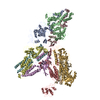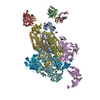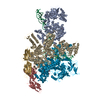+ Open data
Open data
- Basic information
Basic information
| Entry | Database: PDB / ID: 6giy | ||||||
|---|---|---|---|---|---|---|---|
| Title | The baseplate complex from the type VI secretion system | ||||||
 Components Components |
| ||||||
 Keywords Keywords | STRUCTURAL PROTEIN / Secretion / baseplate / complex | ||||||
| Function / homology | Type VI secretion system TssF / Type VI secretion system, TssF / Type VI secretion, TssG-like / Type VI secretion, TssG / Bacterial Type VI secretion, VC_A0110, EvfL, ImpJ, VasE / Type VI secretion system TssK / Type VI secretion system baseplate subunit TssG / Type VI secretion system baseplate subunit TssF / Type VI secretion system baseplate subunit TssK Function and homology information Function and homology information | ||||||
| Biological species |  | ||||||
| Method | ELECTRON MICROSCOPY / single particle reconstruction / cryo EM / Resolution: 4.3 Å | ||||||
 Authors Authors | Rapisarda, C. / Fronzes, R. | ||||||
 Citation Citation |  Journal: Nat Microbiol / Year: 2018 Journal: Nat Microbiol / Year: 2018Title: Biogenesis and structure of a type VI secretion baseplate. Authors: Yassine Cherrak / Chiara Rapisarda / Riccardo Pellarin / Guillaume Bouvier / Benjamin Bardiaux / Fabrice Allain / Christian Malosse / Martial Rey / Julia Chamot-Rooke / Eric Cascales / Rémi ...Authors: Yassine Cherrak / Chiara Rapisarda / Riccardo Pellarin / Guillaume Bouvier / Benjamin Bardiaux / Fabrice Allain / Christian Malosse / Martial Rey / Julia Chamot-Rooke / Eric Cascales / Rémi Fronzes / Eric Durand /  Abstract: To support their growth in a competitive environment and cause pathogenesis, bacteria have evolved a broad repertoire of macromolecular machineries to deliver specific effectors and toxins. Among ...To support their growth in a competitive environment and cause pathogenesis, bacteria have evolved a broad repertoire of macromolecular machineries to deliver specific effectors and toxins. Among these multiprotein complexes, the type VI secretion system (T6SS) is a contractile nanomachine that targets both prokaryotic and eukaryotic cells. The T6SS comprises two functional subcomplexes: a bacteriophage-related tail structure anchored to the cell envelope by a membrane complex. As in other contractile injection systems, the tail is composed of an inner tube wrapped by a sheath and built on the baseplate. In the T6SS, the baseplate is not only the tail assembly platform, but also docks the tail to the membrane complex and hence serves as an evolutionary adaptor. Here we define the biogenesis pathway and report the cryo-electron microscopy (cryo-EM) structure of the wedge protein complex of the T6SS from enteroaggregative Escherichia coli (EAEC). Using an integrative approach, we unveil the molecular architecture of the whole T6SS baseplate and its interaction with the tail sheath, offering detailed insights into its biogenesis and function. We discuss architectural and mechanistic similarities but also reveal key differences with the T4 phage and Mu phage baseplates. | ||||||
| History |
|
- Structure visualization
Structure visualization
| Movie |
 Movie viewer Movie viewer |
|---|---|
| Structure viewer | Molecule:  Molmil Molmil Jmol/JSmol Jmol/JSmol |
- Downloads & links
Downloads & links
- Download
Download
| PDBx/mmCIF format |  6giy.cif.gz 6giy.cif.gz | 629.7 KB | Display |  PDBx/mmCIF format PDBx/mmCIF format |
|---|---|---|---|---|
| PDB format |  pdb6giy.ent.gz pdb6giy.ent.gz | 524.2 KB | Display |  PDB format PDB format |
| PDBx/mmJSON format |  6giy.json.gz 6giy.json.gz | Tree view |  PDBx/mmJSON format PDBx/mmJSON format | |
| Others |  Other downloads Other downloads |
-Validation report
| Summary document |  6giy_validation.pdf.gz 6giy_validation.pdf.gz | 976 KB | Display |  wwPDB validaton report wwPDB validaton report |
|---|---|---|---|---|
| Full document |  6giy_full_validation.pdf.gz 6giy_full_validation.pdf.gz | 1011.1 KB | Display | |
| Data in XML |  6giy_validation.xml.gz 6giy_validation.xml.gz | 94.9 KB | Display | |
| Data in CIF |  6giy_validation.cif.gz 6giy_validation.cif.gz | 145.8 KB | Display | |
| Arichive directory |  https://data.pdbj.org/pub/pdb/validation_reports/gi/6giy https://data.pdbj.org/pub/pdb/validation_reports/gi/6giy ftp://data.pdbj.org/pub/pdb/validation_reports/gi/6giy ftp://data.pdbj.org/pub/pdb/validation_reports/gi/6giy | HTTPS FTP |
-Related structure data
| Related structure data |  0008MC  0009C  0010C  6gj1C  6gj3C M: map data used to model this data C: citing same article ( |
|---|---|
| Similar structure data |
- Links
Links
- Assembly
Assembly
| Deposited unit | 
|
|---|---|
| 1 |
|
- Components
Components
| #1: Protein | Mass: 66557.125 Da / Num. of mol.: 2 Source method: isolated from a genetically manipulated source Source: (gene. exp.)   #2: Protein | | Mass: 41216.344 Da / Num. of mol.: 1 Source method: isolated from a genetically manipulated source Source: (gene. exp.)   #3: Protein | Mass: 49898.121 Da / Num. of mol.: 6 Source method: isolated from a genetically manipulated source Source: (gene. exp.)   |
|---|
-Experimental details
-Experiment
| Experiment | Method: ELECTRON MICROSCOPY |
|---|---|
| EM experiment | Aggregation state: PARTICLE / 3D reconstruction method: single particle reconstruction |
- Sample preparation
Sample preparation
| Component | Name: Complex of TssK, TssF and TssG, components of the type VI secretion system baseplate Type: CELL / Entity ID: all / Source: RECOMBINANT |
|---|---|
| Source (natural) | Organism:  |
| Source (recombinant) | Organism:  |
| Buffer solution | pH: 7.5 |
| Specimen | Conc.: 0.2 mg/ml / Embedding applied: NO / Shadowing applied: NO / Staining applied: NO / Vitrification applied: YES |
| Vitrification | Cryogen name: ETHANE |
- Electron microscopy imaging
Electron microscopy imaging
| Experimental equipment |  Model: Titan Krios / Image courtesy: FEI Company |
|---|---|
| Microscopy | Model: FEI TITAN KRIOS |
| Electron gun | Electron source:  FIELD EMISSION GUN / Accelerating voltage: 300 kV / Illumination mode: FLOOD BEAM FIELD EMISSION GUN / Accelerating voltage: 300 kV / Illumination mode: FLOOD BEAM |
| Electron lens | Mode: BRIGHT FIELD / Nominal magnification: 130000 X / Nominal defocus max: 2000 nm / Nominal defocus min: 700 nm / Calibrated defocus min: 400 nm / Calibrated defocus max: 3000 nm / Cs: 2.7 mm |
| Specimen holder | Cryogen: NITROGEN |
| Image recording | Electron dose: 1.5 e/Å2 / Detector mode: COUNTING / Film or detector model: GATAN K2 SUMMIT (4k x 4k) |
- Processing
Processing
| EM software |
| |||||||||||||||||||||||||||
|---|---|---|---|---|---|---|---|---|---|---|---|---|---|---|---|---|---|---|---|---|---|---|---|---|---|---|---|---|
| CTF correction | Type: PHASE FLIPPING AND AMPLITUDE CORRECTION | |||||||||||||||||||||||||||
| Symmetry | Point symmetry: C1 (asymmetric) | |||||||||||||||||||||||||||
| 3D reconstruction | Resolution: 4.3 Å / Resolution method: FSC 0.143 CUT-OFF / Num. of particles: 32504 / Symmetry type: POINT | |||||||||||||||||||||||||||
| Atomic model building | Protocol: RIGID BODY FIT / Space: REAL |
 Movie
Movie Controller
Controller











 PDBj
PDBj